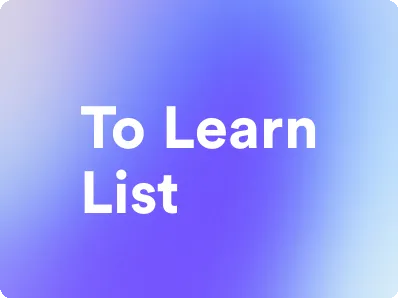To-Learn List: A Productivity Tool for Personal Development
This guide will walk you through the essential elements of using to learn list - the productivity method to keep your team productive and engaged.
Try Lark for Free
In today's fast-paced world, the quest for personal and professional development has become increasingly paramount. As a result, individuals are constantly seeking methods to enhance their skills and knowledge. One effective tool that has gained significant attention in this pursuit is the to-learn list. This article delves into the concept of the to-learn list, its origin, benefits, drawbacks, and provides a comprehensive guide on how to incorporate it into one's daily routine.
What is a To-Learn List in the Context of Productivity?
A to-learn list is a structured inventory of the various skills, competencies, and knowledge areas that an individual aims to acquire or develop. It serves as a strategic roadmap for personal growth and learning. This list is often dynamic, enabling the addition and removal of items based on changing priorities and interests. By leveraging a to-learn list, individuals can systematically organize their learning objectives and track their progress effectively.
What is the Origin of To-Learn List?
The concept of to-learn list finds its roots in the productivity and personal development domains. It has evolved as a response to the increasing need for structured self-improvement. The to-learn list draws inspiration from the well-established practice of setting goals and objectives to enhance productivity and achieve personal milestones. By integrating the learning aspect into this framework, the to-learn list serves as a comprehensive tool for holistic development.
Use Lark to unleash your team productivity.
Who is To-Learn List for?
The to-learn list is tailored for individuals across various demographics and professions who are keen on advancing their knowledge and skills. It is particularly beneficial for:
- Students aspiring to master new subjects or languages
- Professionals seeking to acquire additional certifications or skill sets
- Entrepreneurs aiming to diversify their knowledge base
- Creatives looking to explore new artistic or technical competencies
What are the Pros and Cons of To-Learn List?
Pros
1. Structured Learning: By outlining specific areas of interest, the to-learn list provides a structured approach to learning, ensuring that efforts are focused and deliberate.
2. Motivational Tool: The to-learn list serves as a source of motivation, as individuals can visualize their learning goals and track their progress, leading to a sense of accomplishment.
3. Enhanced Time Management: It assists in effective time management by prioritizing learning objectives and allocating time and resources efficiently.
Cons
1. Overwhelming Scope: Individuals may risk overcommitting by adding an excessive number of learning objectives to the list, leading to feelings of overwhelm.
2. Rigid Framework: A rigid adherence to the to-learn list may hinder the exploration of spontaneous learning opportunities that could be equally beneficial.
3. Potential for Frustration: Inability to check off items on the list within the intended timeline might lead to frustration and demotivation.
Learn more about Lark x Productivity
How to Get Started with To-Learn List?
Embarking on the to-learn list journey involves a series of deliberate steps designed to set the foundation for effective learning and growth. Here's a guide to help individuals get started:
1. Identify Learning Objectives: Begin by identifying specific skills, competencies, or knowledge areas that you aspire to acquire or improve upon.
2. Set Priorities: Prioritize the identified learning objectives based on their relevance and impact on your personal or professional development.
3. Create a Learning Schedule: Allocate dedicated time slots in your daily or weekly schedule to focus on learning activities related to the identified objectives.
4. Utilize Learning Resources: Identify and gather relevant learning resources such as books, online courses, or mentors to support your learning journey.
5. Track Progress: Regularly review and update your to-learn list to track your progress and adjust your learning goals as needed.
Use Lark to unleash your team productivity.
Actionable Tips for To-Learn List
Effectively implementing a to-learn list requires the incorporation of actionable strategies and best practices. Consider the following tips to optimize your to-learn list experience:
- Break Down Learning Objectives: Divide complex learning objectives into smaller, manageable tasks to facilitate steady progress.
- Utilize Technology: Leverage digital tools and apps designed for creating and managing to-learn lists to enhance organization and accessibility.
- Seek Feedback: Engage with peers or mentors to gain insights and feedback on your learning objectives and progress.
- Embrace Flexibility: Remain open to modifying or adding new learning objectives based on evolving interests and opportunities.
Do's and Dont's
The table below outlines the essential do's and dont's to consider when engaging with a to-learn list:
| Do's | Dont's |
|---|---|
| Set realistic and achievable goals | Overload the to-learn list with excessive objectives |
| Review and update the list regularly | Rigidly adhere to the original list without revision |
| Seek diverse learning opportunities | Neglect to celebrate achievements and milestones |
| Prioritize learning based on relevance | Overlook the importance of balancing learning efforts |
Conclusion
In conclusion, the to-learn list stands out as a valuable tool for those committed to continual learning and personal development. By effectively structuring learning objectives and embracing a proactive mindset, individuals can harness the potential of the to-learn list to chart a path toward success and fulfillment in their personal and professional endeavors.
